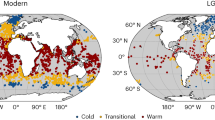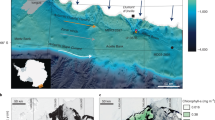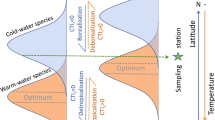Abstract
Explanations for the temporal and spatial patterns of species biodiversity focus on stability–time1–3, disturbance–mosaic (biogenie microhabitat heterogeneity)4,5 and competition–predation (biotic interactions)6,7 hypotheses. The stability–time hypothesis holds that high species diversity in the deep sea and in the tropics reflects long-term climatic stability3. But the influence of climate change on deep-sea diversity has not been studied and recent evidence suggests that deep-sea environments undergo changes in climatically driven temperature8 and flux of nutrients9 and organic-carbon10 during glacial–interglacial cycles. Here we show that Pliocene (2.85–2.40 Myr) deep-sea North Atlantic benthic ostracod (Crustacea) species diversity is related to solar insolation changes caused by 41,000-yr cycles of Earth's obliquity (tilt). Temporal changes in diversity, as measured by the Shannon–Weiner index, H(S), correlate with independent climate indicators of benthic foraminiferal oxygen-isotope ratios (mainly ice volume11–13) and ostracod Mg:Ca ratios (bottom-water temperature8). During glacial periods, H(S) = 0.2–0.6, whereas during interglacials, H(S) = 1.2–1.6, which is three to four times as high. The control of deep-sea benthic diversity by cyclic climate change at timescales of 103–104 yr does not support the stability–time hypothesis because it shows that the deep sea is a temporally dynamic environment. Diversity oscillations reflect large-scale response of the benthic community to climatically driven changes in either thermohaline circulation, bottom temperature (or temperature-related factors) and food, and a coupling of benthic diversity to surface productivity.
This is a preview of subscription content, access via your institution
Access options
Subscribe to this journal
Receive 51 print issues and online access
$199.00 per year
only $3.90 per issue
Buy this article
- Purchase on Springer Link
- Instant access to full article PDF
Prices may be subject to local taxes which are calculated during checkout
Similar content being viewed by others
References
Sanders, H. L. Am. Nat. 102, 243–282 (1968).
Fischer, A. G. Evolution 14, 64–81 (1960).
Hessler, R. R. & Sanders, H. L. Deep-Sea Res. 14, 65–78 (1967).
Hutchinson, G. E. Am. Nat. 93, 145–159 (1959).
Grassle, J. F. & Maciolek, N. J. Am. Nat. 139, 313–341 (1992).
Paine, R. T. Am. Nat. 100, 65–75 (1966).
Pianka, E. M. Am. Nat. 100, 33–46 (1966).
Dwyer, G. D. et al. Science 270, 1347–1351 (1995).
Boyle, E. A. & Keigwin, L. D. Science 218, 784–787 (1982).
Thomas, E., Booth, L., Maslin, M. & Shackleton, N. J. Paleoceanography 10, 545–562 (1995).
Shackleton, N. J. & Opdyke, N. Quat. Res. 3, 39–55 (1973).
Raymo, M. E., Ruddiman, W. F., Backman, J., Clement, B. M. & Martinson, D. G. Paleoceanography 4, 413–446 (1989).
Raymo, M. E., Hodell, D. & Jansen, E. Paleoceanography 7, 645–672 (1992).
Imbrie, J. et al. Paleoceanography 7, 701–738 (1992).
Shackleton, N. J. et al. Nature 307, 620–623 (1984).
Berger, A. L. Quat. Sci. Rev. 11, 571–582 (1992).
Whatley, R. Application of Ostracoda (ed. Maddocks, R. F.) 51–77 (University of Houston Press, Texas, 1983).
Benson, R. H. Palaeogeogr. Palaeoclimatol, Palaeoecol. 48, 107–141 (1984).
Huston, M. A. Biological Diversity (Cambridge University Press, Cambridge, 1994).
Whatley, R. C. & Coles, G. Revista Eapanola de Micropaleontologie 19, 33–97 (1987).
Cronin, T. M. Microfossils and Oceanic Environments (eds Moquilevsk, A. & Whatley, R. C.), (University of Wales, Aberystwyth, 1996).
Buzas, M. A. Taxon 21, 275–286 (1972).
Imbrie, J. et al. Paleoceanography 8, 699–736 (1993).
Berggren, W. A., Kent, D. V., Swisher, C. III & Aubrey, M.-P. SEPM Spec. Publ. No. 54, 129–212 (1995).
Dingle, R. V. & Lord, A. R. Palaeogeogr., Palaeoclimatol., Palaeoecol. 99, 213–235 (1990).
Cronin, T. M., Raymo, M. E. & Kyle, K. P. Geology 24, 695–698 (1996).
Versteeg, G. Mar. Micropal. 23, 147–183 (1994).
Backman, J., Pestiaux, P., Zimmerman, H. & Hermelin, O. North Atlantic Palaeoceanography (Geol. Soc. Amer. Spec. Publ. No. 21) 231–242 (1986).
Rex, M. A. et al. Nature 365, 636–639 (1993).
Cronin, T. M. et al. Paleoceanography 10, 259–281 (1995).
Author information
Authors and Affiliations
Rights and permissions
About this article
Cite this article
Cronin, T., Raymo, M. Orbital forcing of deep-sea benthic species diversity. Nature 385, 624–627 (1997). https://doi.org/10.1038/385624a0
Received:
Accepted:
Issue Date:
DOI: https://doi.org/10.1038/385624a0
This article is cited by
-
Combining Small-Vertebrate, Marine and Stable-Isotope Data to Reconstruct Past Environments
Scientific Reports (2015)
-
The temporal dimension of marine speciation
Evolutionary Ecology (2012)
-
An oblique slant on deep-sea biodiversity
Nature (1997)
Comments
By submitting a comment you agree to abide by our Terms and Community Guidelines. If you find something abusive or that does not comply with our terms or guidelines please flag it as inappropriate.



